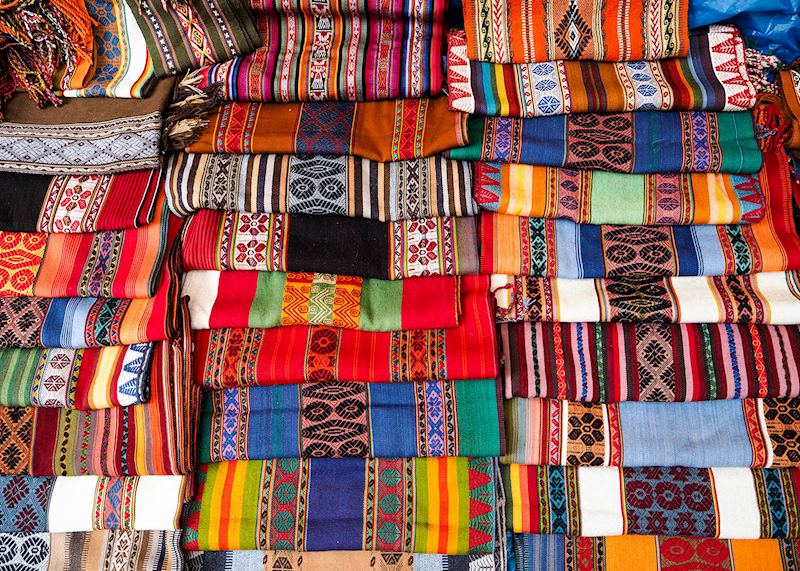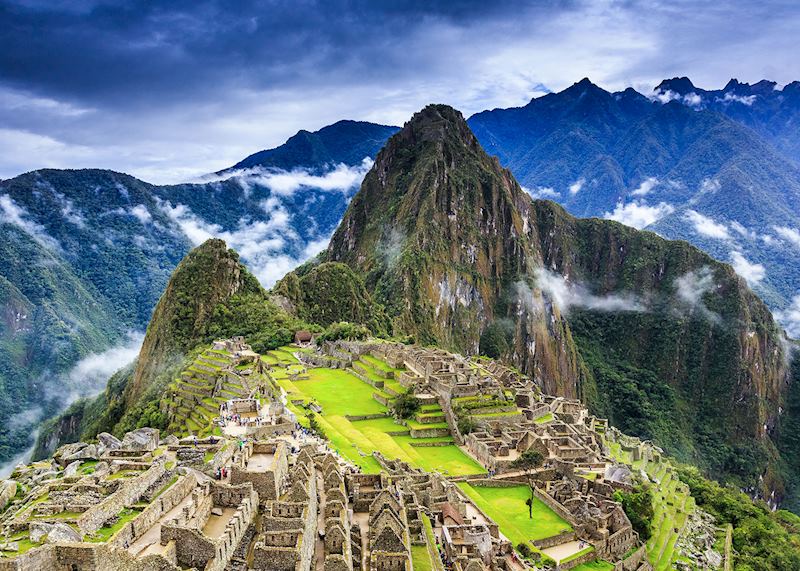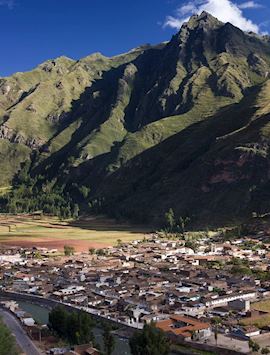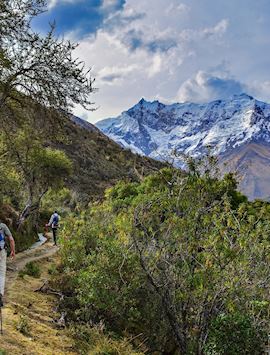By Peru specialist Lauren
I often get asked the following question, albeit rephrased in various ways: “How can I experience Cuzco and Machu Picchu without feeling like I’m part of one big tourist conveyor belt?”
The simple answer is to take advantage of the richness of the activities and experiences you can have in this corner of the world, and to not be afraid of choosing quieter activities that take you away from the main places of interest. To show you what I mean, I’ve created a detailed itinerary for what a trip to Cuzco and Machu Picchu might involve. This particular route also aims to give you a taste of how much there is to see and do in the Sacred Valley — an area often overlooked by most visitors, and rarely given the attention it deserves.
My newly crafted trip is loosely based on this more standard route, but as you’ll see, I’ve suggested some more off-the-beaten-track activities and Inca ruins.
Days 1-3: Cuzco

Day 1: Ideally, you’d arrive in Cuzco in the late afternoon, so you can wake up the next morning feeling refreshed and ready for a private tour of the city and some of its nearby Inca ruins.
Day 2: On the tour, take time to wander between the oversized, zigzagging stones of Sacsayhuamán, the Inca fortress high on a hillside overlooking the city, with your guide. You can also amble around the smaller sites nearby, too. There’s the water temple of Tambomachay, or the ruins of Qenqo, with their sacrificial altar tucked away in the penumbra of a rock crevice. Rather than rush back into the city, you could walk back via Tambomachay, passing through grassy gullies and smallholdings with a scattering of llamas and alpacas en route.
Back in Cuzco, you might like to have a good poke around the remains of the Korikancha, a peculiar palimpsest of a building. The Spanish conquistadors built over what was an Inca sun temple — the most renowned in the entire Inca capital — with their own elaborate convent, but you can still see the temple’s original footprint. The Inca masonry on display shows how stones were precision-fitted using mortise and tenon joints and other techniques.
Day 3: Today, I’d suggest simply spending time exploring the heart of Cuzco at a leisurely pace. You could head to the covered stalls of the San Pedro Market, just off the Plaza de Armas (the main square), to browse its assorted (and sometimes eccentric) offerings. Here, you’ll find everything from bathmats to dried bats (take a peek at the witch-doctors’ stalls, if you want to see even curiouser traditional shamanic remedies on offer.) If it were me, I’d spend most of my time pouring over the textiles and woven goods, bartering with the stallholders. I’d also go in search of some subtle and delicious lemongrass teabags I once found here a couple of years ago.
For lunch or a breather, try to find a spot in a café on the Plaza de Armas and just watch the world go by. Yes, you’ll see lots of fellow foreign visitors, but you might also see children in school uniforms, men of the cloth (Cuzco is chock-full with churches), and Quechua-speaking ladies in their wide skirts and Stetson-style hats. It’s a good way of observing local life without having to do all that much.
Once refreshed (ideally with a hearty quinoa soup), you might like to lose yourself in the backstreets of Cuzco’s self-styled artisan district, San Blas. You can stroll up to a viewpoint on a hill behind the cathedral in the heart of this quarter and nose around its homemade trinkets and handicraft boutiques.
Where to stay in Cuzco
I like Inkaterra la Casona, a restored Spanish colonial manor house that’s a short walk from the Plaza de Armas. Rooms either overlook a green-lawned central courtyard, a peaceful oasis in the heart of the city, or have balconies with views over the rooftops.
Days 4-6: The Sacred Valley

Day 4: Leaving the city behind, you drive into the Sacred Valley, a verdant corridor in the Andes between Cuzco and Machu Picchu that many visitors overlook. This is a shame, because there’s so much to do here. It’s also an area that’s of huge importance historically to the Inca Empire, as its lower elevation and warmer climate (compared to Cuzco) made it ideal for growing crops such as maize.
In the latter years of the empire, the upper echelons of Inca society built their country homes and estates here. Today, the valley is also strewn with sites and ruins that were of military and strategic importance.
En route to your hotel in the valley proper, visit Písac with your guide. A behemoth citadel complex, it’s a good precursor to Machu Picchu and even occupies a similar lofty perch, with its terraces straddling a mountain spur. If you’re feeling energetic, climb to the top of the ruins to see a former Inca bathing area and some nooks in the mountainside where the Incas stowed their mummified dead.
I also suggest making time to walk around the town’s craft market. But if your first day in the Sacred Valley coincides with a Sunday, skip Písac’s market and head for the nearby town of Chinchero. Its dominical market is one big, joyous riot of indigenous stallholders in traditional dress selling heaps of fresh fruit and vegetables.
And, if you’d really like to sample the Sacred Valley’s bounty at its best, I’ll reserve you a table at MIL Centro. A food laboratory-come-gourmet restaurant, it’s inspired by the adjacent ruins of Moray (see below), where the Incas experimented with growing crops at different altitudes in concentric circles of terracing. Try the tasting menu, where, taking its cue from Moray, chefs go to town with local ingredients from different ecosystems and altitudes, like varieties of corn and potatoes, coca leaves, and cabuya (agave) nectar.
Day 5: Throw yourself into the Sacred Valley’s scenery with a full day’s privately guided mountain biking, with an accompanying support vehicle. Skimming between rocky outcrops, fields of quinoa crops, and tiny villages that would never make it into any guidebook, I think mountain biking is a really good way of experiencing the valley’s Inca sites and pastoral landscapes and seeing how its people really live. Another bonus about mountain biking here: it’s all mostly flat and hardly ever uphill.
You’ll cycle to the salt pans of Maras and then to Moray, for a closer look at this most curious of archaeological sites with its three vast green vortexes swirling down into the mountainside.
Day 6: On the morning of your second full day in the Sacred Valley, I suggest visiting a small women’s weaving cooperative, high in the remote Patacancha Valley. If you’re at all interested in Peruvian textiles, this makes for a really fulfilling, authentic cultural encounter.
Through your Quechua-speaking interpreter, the artisans will show you how they spin yarn by hand using a pushka, a traditional Andean drop spindle (so much harder than it looks, let me tell you) and how they use dyes.
You’ll get a chance to try your hand at weaving a bracelet on a backstrap loom before you all sit down to a pachamanca lunch — vegetables and meat cooked slowly underground in an earth oven until they emerge, succulent and smoky, and then slathered with pepper sauce.
I’d schedule this activity for the morning, and then return to your hotel after your hearty lunch to spend the rest of the day relaxing by the pool.
Where to stay in the Sacred Valley
My go-to retreat has to be the Sol y Luna. Not only can you set out on mountain biking trips from here, but it’s also a great place to unwind. Its restful gardens are alive with hummingbirds and butterflies, and you can swim in its heated pool, enjoy a treatment in the spa, and watch the mountainsides become patterned with rich shades of chocolate and ochre as the sun sets. You can even eat lunch while watching a display of the hotel’s Paso Fino horses.
Days 7-9: Machu Picchu

Day 7: Think about approaching Machu Picchu on foot (rather than train then bus). The good news is that you needn’t take the time and expense to do the four-day Inca Trail, as rewarding as it is.
Instead, today, you catch the train from Ollantaytambo with your guide, disembarking half an hour before reaching Aguas Calientes (the town that services Machu Picchu) where you cross a bridge over the Vilcanota River. This is the start of KM 104, a 10-km (6-mile) hike that culminates at Machu Picchu’s Sun Gate.
It allows you to arrive on foot, the way Inca messengers did, but you bypass the three nights’ camping that’s obligatory for the traditional Inca Trail. And, even though the KM 104 route is getting increasingly popular, there’s still something intrepid about it. This especially applies to the earlier sections, which see you ascend steeply from the river by climbing some exposed ridges (look out for several delicate orchid specimens en route).
You’ll join up with the Inca Trail proper at the ruins of Wiñay Wayna. This group of llama-haunted Inca terraces concertina down the mountainside and contain the remains of spring-fed baths. From this way-marker, it’s another hour or so to the Sun Gate, where you’ll get your first sidelong glimpse of Machu Picchu. Don’t worry if you see nothing but cloud at first: this is sometimes the case. If that happens, just hang around for a few minutes, and the site will gradually unveil itself.
Day 8: Tour the ruins the following day, once you’ve rested after the hike at your hotel in Aguas Calientes. Get there early with your guide in order to explore before the majority of visitors arrive mid-morning. The site has set routes you’re required to follow, so I’ll arrange tickets for the most complete of them, which not only leads you to the best vantage point over the citadel, but offers a comprehensive circuit of the central part of the ruins.
As the crowds arrive, climb Machu Picchu Mountain, the peak that sits south of the skeletal ruins. Entry to the climb is timed, requires a separate ticket, and requires fitness and a bit of prior hiking experience. It’s a fairly unrelenting, stepped ascent, bringing you 600 m (2,000 ft) above the site itself. But, it’s worth it for the views of Machu Picchu seemingly suspended amid a great bowl of forested Andean peaks, with the witch’s hat peak of Huayna Picchu looming behind it.
Afterward, head back into Aguas Calientes to relax in the jungle-clad grounds of your hotel, the Inkaterra Machu Picchu Pueblo, rather than rush back to Cuzco (as most people do). Soak in its hot tubs, relax in its spa, wander in its orchid gardens, and try to spy some of the many species of hummingbird that jostle around its feeders.
Day 9: To make the most of staying at the Inkaterra Machu Picchu Pueblo, I suggest staying at your hotel until lunchtime, before taking the train back to Cuzco in the afternoon.
Where to stay at Machu Picchu
The above Inkaterra Machu Picchu Pueblo is always my first choice, and it has added attractions to its many good facilities. I love the fact that every room has its own fireplace, and staff will light a fire for you in the grate.
Read more about trips to Peru
Start thinking about your experience. These itineraries are simply suggestions for how you could enjoy some of the same experiences as our specialists. They're just for inspiration, because your trip will be created around your particular tastes.
View All Tours in Peru



